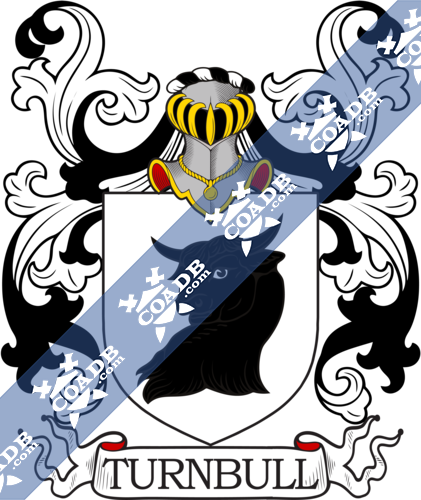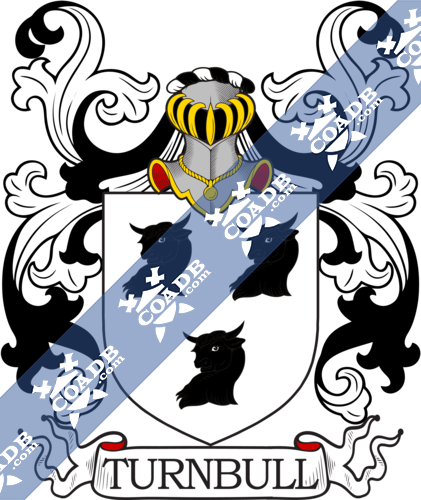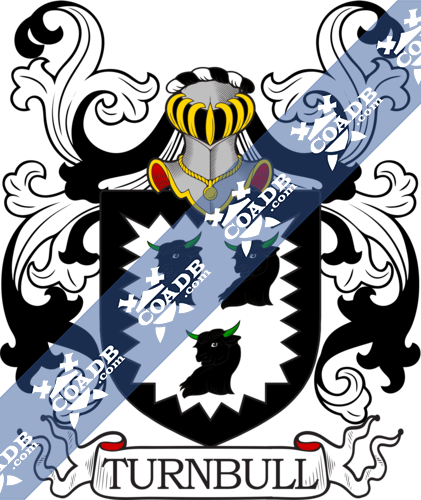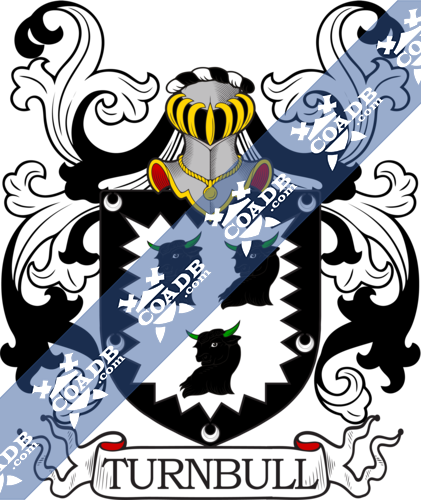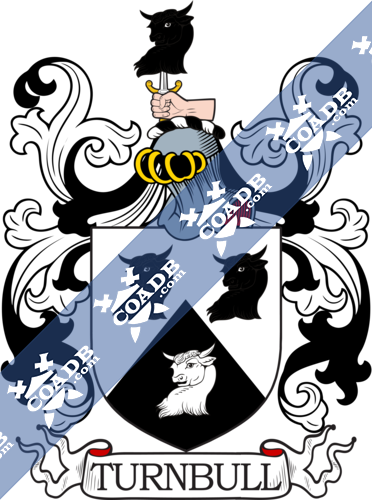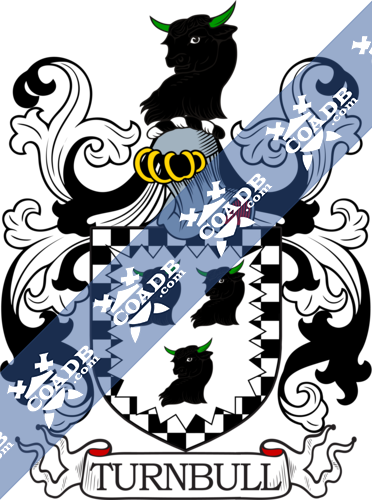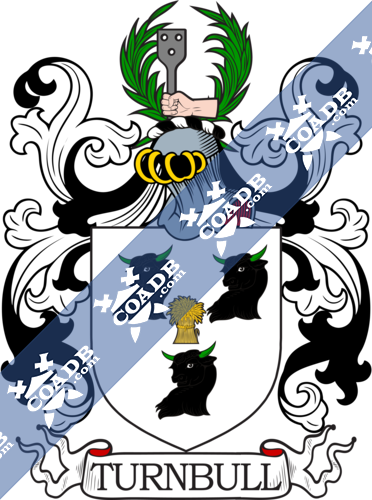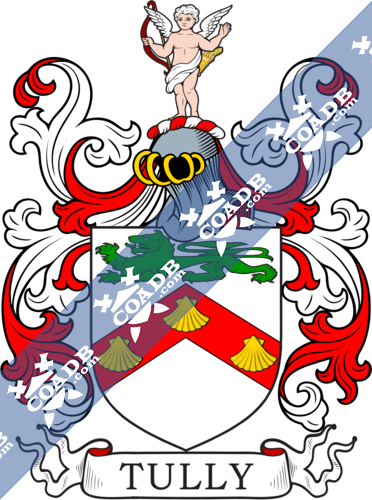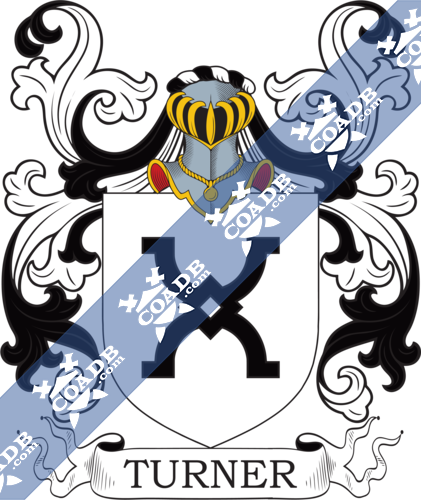Turnbull Family Crest, Coat of Arms and Name History
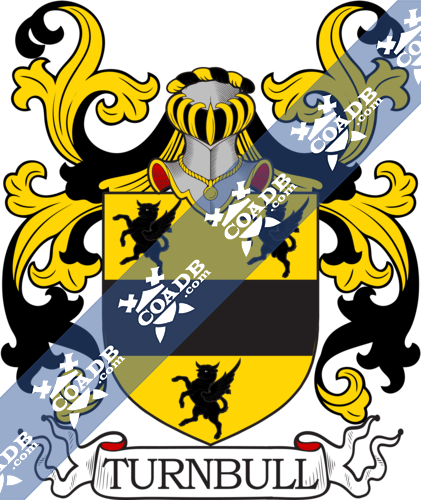
Turnbull Coat of Arms Gallery
Don’t know which Coat of Arms is yours?
We can do a genealogical research. Find out the exact history of your family!
Learn MoreTurnbull Origin:
England
Origins of Turnbull:
This interesting name, mainly found noted in Northern England and Scotland, is of Anglo-Saxon origin, and is a nickname surname for a man considered to have been strong enough to turn back a charging bull. The name acquired from the Middle English (1200 – 1500) “turn(en)”, to turn, from the Olde English pre 7th Century “turnain”, which is similar to the Old French “torner”, both of which are from the Latin “tornare”, and the Middle English “bul(l)e”, a bull. A sizeable group of early European surnames gradually formed from the habitual use of nicknames.
Variations:
More common variations are: Turnbuall, Turnnbull, Tournbull, Turnbulle, Tiurnbull, Turnbiull, Turn Bull, Turnbul, Turnball.
Scotland:
The surname Turnbull first appeared in Roxburghshire. Referring to the Rule mentioned above reference, there was a noble family of Rule, which acquired its name from the Water of Rule, an affluent of the Teviot. This family dates back to 1214 when King William the Lion of Scotland given lands to Alan de Rule. If the bull episode is true, then the bearer was either Adam de Rule or Thomas de Rule, the two Rule chieftains who appeared on the Ragman Rolls in 1296, just after the Stirling Park affair. Later, King Robert the Bruce did in fact grant lands in the west of Fulhophalche to William Turnbull in 1315. King David II also given the lands of Humdallwalschop (now Hundleshop) to John Turnbull.
England:
The very first recording spelling of the family was shown to be that of William Turbolle, dated about 1272, in the “Subsidy Rolls of Suffolk”. It was during the time of King Edward II, who was known to be the “Edward of Caernafon”, dated 1307 – 1327. The origin of surnames during this period became a necessity with the introduction of personal taxation. It came to be known as Poll Tax in England. Surnames all over the country began to develop, with unique and shocking spelling varieties of the original one.
Ireland:
Many of the people with surname Turnbull had moved to Ireland during the 17th century.
United States of America:
Individuals with the surname Turnbull landed in the United States in three different centuries respectively in the 17th, 18th, and 19th. Some of the people with the name Turnbull who arrived in the United States in the 17th century included Alexander Turnbull, who settled in East New Jersey in 1684.
People with the surname Turnbull who landed in the United States in the 18th century included James Turnbull, who arrived in Charles Town [Charleston], South Carolina in 1734. John Turnbull settled in Annapolis, Maryland in 1753. George Turnbull, who settled in New York in 1756.
The following century saw more Turnbull surnames arrive. Some of the people with the surname Turnbull who arrived in the United States in the 19th century included Gavin Turnbull, aged 46, landed in South Carolina in 1812.
Canada:
People with the surname Turnbull settled in Canada in two different centuries respectively in 18th and 19th. Some of the people with the surname Turnbull who came to Canada in the 18th century included William Turnbull settled in Bonavista, Newfoundland in 1765. Foster Turnbull, who came to Halifax, Nova Scotia in 1774. Foster Turnbull, who arrived in Nova Scotia in 1774.
The following century saw much more Turnbull surnames arrive. People with the surname Turnbull who settled in Canada in the 19th century included Euphemia Turnbull, who settled in Nova Scotia in 1818.
Australia:
Some of the individuals with the surname Turnbull who landed in Australia in the 19th century included William Turnbull, English convict from Middlesex, who was transported aboard the “Agamemnon” on April 22, 1820, settling in New South Wales, Australia. Isaac Turnbull, a farrier, arrived in New South Wales, Australia sometime between 1825 and 1832. Archibald Turnbull, a Dyer, arrived in New South Wales, Australia sometime between 1825 and 1832.
New-Zealand:
Some of the population with the surname Turnbull who arrived in New Zealand in the 19th century included Dr. Turnbull landed in Wellington, New Zealand in 1842 aboard the ship London. George Turnbull, aged 25, a farm laborer, arrived in Otago aboard the ship “Philip Laing” in 1848.
Here is the population distribution of the last name Turnbull:
England 14,772; United States 10,309; Australia 7,843; Canada 5,326; Scotland 3,498; South Africa 3,105; New Zealand 1,714; Mexico 733; Wales 463; Jamaica 339
Notable People:
Alan Turnbull was Lord Turnbull.
Andrew Turnbull (colonist) (1718–1792), was an early British colonizer of Florida.
Blazons & Genealogy Notes
1) (Thomas Turnbull, temp. Henry VIII.; impaled by Emakuel Lucas, Esq., of London, whose second wife was Joane, dau. of Thomas Turnbull. Visit. London, 1563). Or, a fess betw. three winged bulls sa.
2) (Bedrule, co. Berwick). Ar. a bull’s head erased sa.; afterwards Ar. three bulls’ heads erased sa.
3) (Bedrule, co. Berwick). Ar. a bull’s head erased sa.; afterwards Ar. three bulls’ heads erased sa.
4) (Minto, co. Berwick, 15th century). Ar. a bull’s head cabossed sa.
5) (Know, co. Berwick). Motto—Courage. Ar. an ear of rye vert betw. three bulls’ heads erased sa. armed of the second. Crest—A bull’s head cabossed sa. armed vert.
6) (Stracathrow, co. Forfar). Motto—Audaci favet fortuna. Ar. three bulls’ heads erased sa. armed vert, within a bordure indented of the second.
7) (Smiddyhall, co. Forfar). As the last, but the bordure charged with six crescents ar. for diff. Same Motto.
8) (James Turnbull, nephew of Stracathrow, 1696). Motto—Audacior favente fortuna. Ar. three boars’ heads erased sa. armed vert, within a bordure indented and chequy of the second and first. Crest—A bull’s head erased, as in the arms.
9) (Currie, Scotland, 1685). Motto—Favet fortuna labori. Ar. a garb ppr. betw. three bulls’ heads erased sa. armed vert. Crest—A dexter hand holding up a baxter’s pyle charged with three loaves in pale ar. all within two bunches of palm vert.
10) (Abbey St. Bathans, co. Berwick). Motto—I saved the King. Per chev. ar. and sa. three bulls’ heads counterchanged. Crest—A dexter hand couped fessways ppr. holding up a dagger erect also ppr. hilted and pommelled or, bearing on the point a bull’s head erased sa.
11) (Glasgow, 1869). Motto—Audaci favet fortuna. Ar. in chief two bulls’ heads erased sa. and in base an oak tree eradicated in beni’i sinister surmounted of a sword in bend ensigned with an antique crown all ppr. Crest—A hand holding a dagger erect ppr. having on the point a bull’s head erased sa.

